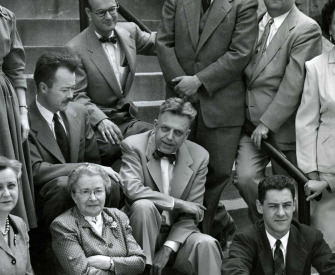Drinking with women is as unnatural as scolding with ’em.
—William Wycherley, 1675Reconstructing the Hallucination
Nick Reding documents a meth high gone wrong.
On a cold winter night, Roland Jarvis looked out the window of his mother’s house and saw that the Oelwein police had hung live human heads in the trees of the yard. Jarvis knew the police did this when they meant to spy on people suspected of being meth cooks. The heads were informants, placed like demonic ornaments to look in the windows and through the walls.
As Jarvis studied them, they mumbled and squinted hard to see what was inside the house. Then the heads—satisfied that Jarvis was in fact cooking meth in the basement—conveyed the message to a black helicopter hovering over the house. The whoosh of the blades was hushed and all but inaudible, so Jarvis didn’t notice the helicopter until he saw the heads tilt back on their limbs and stare at the cold night sky. By then, Jarvis knew he had to hurry: once the helicopter sent coordinates to the cop shop, it would be only moments before they raided the house.
Jarvis ran downstairs to the basement. He was wearing a Minnesota Vikings tank top, a pair of boxer shorts, and white tube socks. A divorced thirty-five-year-old father of four who’d been making meth since the mid-1990s and using the drug since he was sixteen, Jarvis had been in jail all but three of the last ten years. He did not want to go back. So bottle by bottle and container by container, he poured down the flood drain in the floor of his mother’s basement the chemicals he had stored there: anhydrous ammonia, Coleman lantern fluid, denatured alcohol, and kerosene. Finally he poured two gallons of hydrochloric acid down the drain. Then he lit a cigarette.
People around town like to say that Roland Jarvis blew himself up. The sound Jarvis heard immediately following the click of his lighter, though, was not anything like an explosion. It was a very distinct and very quiet sucking sound. It took about a quarter of a second for the ionized hydrogen in the hydrochloric acid to propagate from the lighter’s flame and into the drain. This made the entire basement into a vacuum. Jarvis heard a soft Whoomp! Then came the blast, the force of which blew out the windows and singed Jarvis’ body wherever it wasn’t covered by clothing. In the space of several more tenths of a second, all his exposed body hair burned off. When he looked down, he saw that his tube socks were somehow no longer on his feet. When he looked up, he saw that the wooden ceiling was consumed by animate, expanding rivulets of blue flame. His mother, who was something of a pack rat, had stored her deceased husband’s books, clothes, and fishing equipment in boxes in the basement, alongside old furniture she couldn’t bear to sell, for it had been in her family since the days before her grandmother left Sicily. Now all of it was on fire. Oxygen poured into the basement through the blown-out windows, feeding the flames. Jarvis’ tank top was burning, so he took it off and went running up the stairs and onto the porch. He stood there a while, thinking. Then he decided to go back into the house.

Death of Orpheus, by Émile Lévy, 1866. Musée d'Orsay, Paris.
For forty-five minutes, Jarvis made one trip after another into his mother’s home, even as the fire spread from room to room and floor to floor. He filled a plastic mop bucket over and over, and fought the fire relentlessly, stopping every now and again to bring a couch or a table outside into the brutal Iowa night. At one point, dissatisfied with the water output of the kitchen sink, Jarvis claims that he harnessed the superhuman strength afforded him by the dual effects of his meth high and his panicked adrenaline rush to pull the sink from its housing in the counter and throw it against a wall in a blind rage.
Jarvis says he wanted to save the house. It’s considered a foregone conclusion by the police that he was trying to retrieve the remnants of his meth lab, along with the formidable amount of dope that he had been making, for Jarvis, in a town full of meth cooks, was considered one of the finest and most prolific of their number. That, or he was attempting to spread the fire himself in order to burn as much evidence as possible. It’s conceivable, too, that he was in such a state of psychotic disarray, emotional bankruptcy, and physical disembodiment that he was doing all three of those things. What stopped him, in any event, is that he began to melt.
Following one of his trips outside, Jarvis looked down and saw what he thought was egg white on his bare arms. It was not egg white; it was the viscous state of his skin now that the water had boiled out of it. Jarvis flung it off himself, and then he saw that where the egg white had been he could now see roasting muscle. He looked at his legs and his abdomen. His skin was dripping off his body in sheets. Panicked, standing there in the frigid night outside the inferno of his mother’s home, naked but for his boxer shorts, which he’d inadvertently soaked in water while fighting the fire, Roland Jarvis began pushing sheets of skin from himself, using his hands like blunt tools, wiping and shoving the hide from as much of his body as he could reach. He’d have pulled the melting skeins of skin from himself in bigger, more efficient sections, but for the fact that his fingers had burned off of his hands. His nose was all but gone now, too, and he ran back and forth among the gathered neighbors, unable to scream, for his esophagus and his voice box had cooked inside his throat.
The police, says Jarvis, just watched. Jeremy Logan was still a sergeant, and a man with whom Jarvis had gone to high school. When Jarvis approached him, Logan moved away like a matador avoiding a bull, not because he took sadistic pleasure in Jarvis’ plight, but because, as Logan later told me, no one knew what to do. Jarvis begged in vain for someone to shoot him. He was burning alive, and the pain was unbearable. Not even the paramedics knew how to respond, says Jarvis. He says everyone watching—the gathered neighbors, the police, the entire Oelwein fire department—wanted him to die. “And I don’t blame them,” he says. “What else could you do with a man like me?”
Methamphetamine is synonymous with the kind of deranged behavior exemplified by Roland Jarvis both that night and in the nineteen years leading up to it: the stories that Jarvis tells would hardly be believable, were it not for corroboration among his friends and within the pages of police reports that exist solely to catalog the known exploits of a single Oelwein, Iowa, meth cook. Jarvis is just one of many local legends around Fayette County famous for, among so many things, staying high on crank for twenty-eight days straight, an entire lunar cycle. Meth is also responsible for the physical destruction that Jarvis’ body exhibits. By the time I met him, he’d had four heart attacks. He couldn’t sleep and rarely had an appetite. Almost all his teeth were gone, and those that remained were black and decaying. He was in almost constant pain; his muscles ached, and his joints were stiff. Meth’s destructiveness extended, said Jarvis, to his children, one of whom, born at the peak of his parents’ intravenous meth use, was wearing a colostomy bag by the age of ten. Unable to shoot up with the finger nubs left him by the lab explosion, Jarvis had taught himself to hold a pipe and lighter so that he could resume his meth habit once again.

Nick Reding
From Methland. Reding first encountered methamphetamine use in 1999 while researching ranching in Idaho: he met a nineteen-year-old Mexican drug dealer who called himself Coco and said about his business strategy, “At first we give it away. Then the addicts will do anything to get more.” It was estimated in 2008 that 12.6 million Americans had tried meth, and 66 percent of state and local agencies in the West reported that it was their greatest drug threat.


